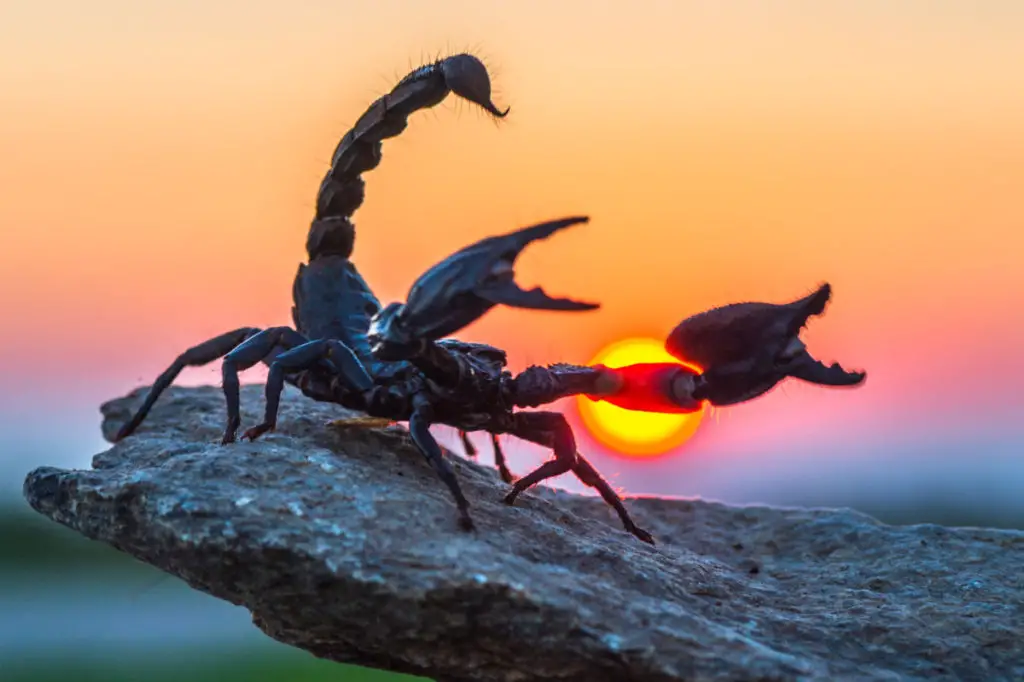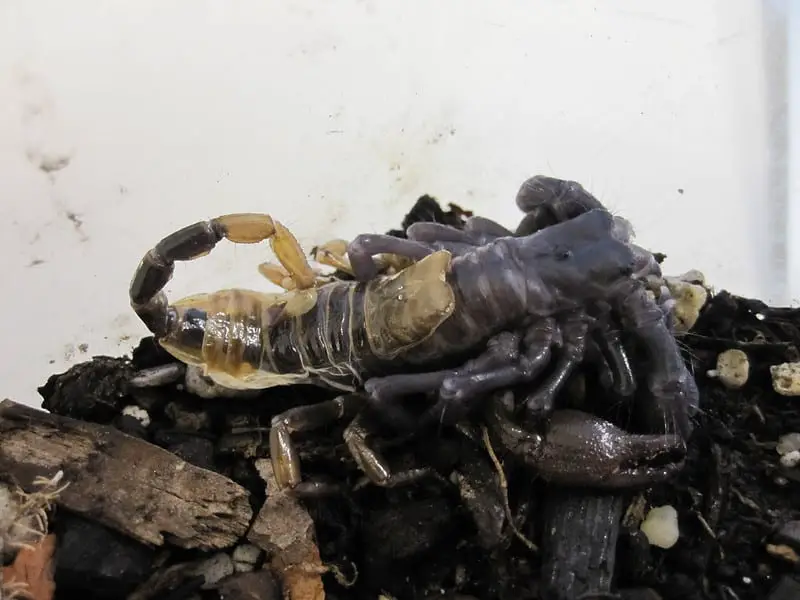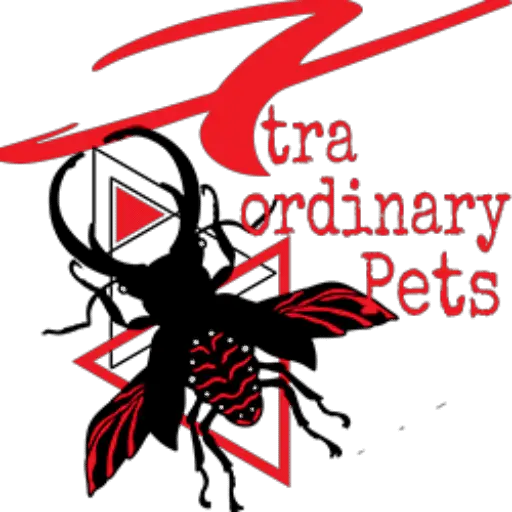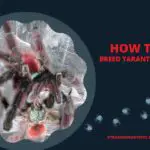Emperor scorpion or Pandinus imperator is a gorgeous creature that can be kept as a pet. In this article, I’ll share how beginners can easily keep and care for emperor scorpions as pets.
To keep emperor scorpion, prepare an enclosure with a proper lid and ventilation. Fill the enclosure with 3-8 inches of moist substrates. House the emperor scorpion and feed it with crickets once a week. Keep the substrate moist by regular misting.
Sounds easy enough isn’t it? Let’s drill into more details.
Profile of Emperor Scorpion

Scientific name: Pandinus imperator
Color: Black
Origin: Tropical Africa
Size: Up to 8 inches (20cm) from head to tail.
Life span: Up to 8 years
Why Emperor Scorpion?
A few characteristics of the emperor scorpions have made it the perfect scorpion to keep for beginners:
Emperor scorpion is docile
When disturbed, the emperor scorpion tends to back off instead of attacking with its pincer or stinger. Just bear in mind that it doesn’t mean they will not attack. They do attack you if they are cornered.
Emperor scorpion is only mildly venomous
Stings from all scorpions are venomous and a handful of them are lethal. Emperor scorpion is a species with only mild venom. Coupled with the fact that it is docile, it is very safe to keep as long as you know what you are doing.
Easy to maintain
Emperor scorpions are big and hardy species which make them easy to handle and maintain. Like other scorpions, they have a very slow metabolism rate and can be fed once a week, or at an even longer interval.
It’s cool
There are just so many people keeping cats and dogs. Be the “cool guy” (also pronounced as “nerd”) who keeps dangerous and mysterious scorpions!
Where to Get An Emperor Scorpion

The popularity of pet emperor scorpions has increased over the years. There are many hobbyists who breed them. So, the good news is you don’t have to import an emperor scorpion from Africa.
Some hobbyists prefer to get wild caught scorpions (which is extremely difficult now due to the regulation) because they are generally larger in size than their captive-bred counterparts.
However, due to excessive collection and destruction of habitats, trading of emperor scorpions is now regulated by CITES (Convention on International Trade in Endangered Species). I’d advise you to get captive-bred emperor scorpion for the sake of their survival in their natural habitats.
Moreover, it is difficult to ascertain the age and health-being of wild-caught scorpions. They might be overly stressed during cross-continent transportation and can die soon after you receive them.
In terms of life stages, try to get an older juvenile, which hobbyists call “sub-adult”. Younger juveniles are more fragile and can be harder to maintain. Meanwhile, if you keep an adult, you will miss the opportunity to witness its growing process. Moreover the adult can be too old and there is no way to tell.
Emperor scorpions can live for 8 years in captivity. The lifespan of male and female emperor scorpions are is not much different. The only difference between the 2 is that male scorpion is smaller in size. So, pick whichever you are happy with.
Note that wild-caught female adult scorpions might come pregnant. But you can always breed your scorpion if you want to.
Emperor Scorpion Tank Setup
The most important thing in emperor scorpion care is setting up the right enclosure. You need to ensure the housing is comfortable enough to meet the necessities of your pet scorpion, and secure enough for you and your family.
An emperor scorpion can be housed in a 5 gallon tank with lots of vents and a secure lid. Aquaria and common exotic pet terraria are good options.
While emperor scorpions are not good climbers, they will climb from the corners of the enclosure. A lid is therefore necessary. Avoid using a lid with mesh cover because the emperor scorpion can easily destroy the mesh.
Prepare peat moss and vermiculite in a 7 to 3 ratio. Add water and mix the substrates evenly. The substrates should be adequately moist so that it holds its shape momentarily when pressed in hands without dripping.
Fill the substrates until it is 3 to 8 inches in depth. Deeper substrates are better for the emperor scorpion because of its burrowing behavior. You can put a cork bark on the substrate for the scorpion to hide or burrow underneath.
Emperor scorpions, especially females, can be housed together in the same container. The key is to use a larger container and ensure sufficient food is provided. However, the risk of cannibalism is always present. Hence, it is not advisable to house them together.
Temperature
Emperor scorpion is best kept somewhere warm between 77 – 86 °F. If the temperature is too low, the scorpion will become inactive and may stop feeding. Meanwhile, the scorpion is more active and grows faster at a higher temperature.
You can use a heat mat to provide additional heat to the emperor scorpion. Fix the heat mat onto the wall of the enclosure. That will create a heat gradient which allows the scorpion to move to the spot it prefers. It also allows the scorpion to hide in the cooler substrates if it’s too hot.
Pay attention to the temperature of your enclosure when using a heat mat so that you don’t bake your emperor scorpion.
Water and Humidity
Being a tropical species, an emperor scorpion prefers a high humidity environment.
Mist the substrates once a week to keep it moist. Place a water dish in the enclosure as a backup in case your emperor scorpion is thirsty. Put a few pebbles in the water dish as an escape path for the feeder crickets to prevent them from drowning.
Lighting
Emperor scorpions are active at night. They do not require additional lighting. Place them away from direct sunlight.
To enjoy observing your scorpion at night, you can use a red LED light. The scorpions are less sensitive to red light and hence will not be disturbed. Using white light may push them back into the burrow.

Scorpions glow under black light. You can shine black light using a torch on your scorpion to observe it’s remarkable glow. Don’t use black light for a prolonged period of time because it harms both your eyes and your scorpion.
How to Feed Emperor Scorpions
Emperor scorpions are carnivorous. Feed them with 3 to 4 crickets once a week. Adjust the amount of food accordingly based on the appetite of your scorpion. Unconsumed crickets should be removed on the next day.
Some hobbyists switch the types of feeders routinely to give their scorpion a more balanced diet. Other feeders that you can try include mealworms, roaches, and even small mice or geckos. I have separate guides on how to keep feeder insects that your can refer to.
If you want to use mealworms, put them into a Petri dish or something similar so that they can’t burrow into the substrates. Some hobbyists claimed both worms have fewer nutrients and hence should be used as a backup when crickets can’t be obtained, instead of being used as the staple meal.
As a general rule of thumb, the size of the feeder should not be more than ⅓ the size of the scorpion. That makes it easier for your scorpion to catch the prey without being injured. On the other hand, they can’t catch prey that are too small either.
Emperor scorpions are good at fasting. Sometimes it can stop feeding for months. If you need to leave home for more than a week, you can feed your scorpions with more food than you normally would. As long as you prepare enough water in the dish, your scorpion will be fine.
Scorpions stop feeding for about a few days before and after molting.
Recommended Supplies
Here are some supplies that you can buy for your emperor scorpions. Note that I get a small commission when you buy the items through the links in this page. This helps me to maintain the site without incurring additional costs to you.
- 10 gal tank
- Coir
- Hide Cave
- Black light LED
- Water bowl
- Tweezers
- Thermometer/Hygrometer
- Heat mat
- Feeder crickets
- Feeder dubia roaches
Molting

Emperor scorpions molt 6 times to become sexually-mature adults. Hobbyists often call the stage immediately prior to the last molt as the “sub-adult”.
As mentioned earlier, scorpions will stop feeding when it is about to molt. It is important to remove all feeder insects in enclosure to avoid disturbance, since the molting emperor scorpion is extremely fragile and vulnerable. As the owner, you should also stop disturbing your scorpion and ensure it is in a safe environment.
After molting, the exoskeleton of the scorpion will remain soft. Wait until it is fully hardened before you start to reintroduce food. Make sure that water is always present in the water dish because enough water will help facilitate molting.
Emperor Scorpion Handling
While the emperor scorpions are docile and rarely sting, I still advise you not to handle them as much as possible. But there are situation where you need to handle them, eg. when they escaped or when you needed to re-house them.
Prepare yourself 2 pairs of long tweezers with rubber pads (affiliate link). If your tweezers don’t have rubber pads, you can DIY using small rubber tubes. The purpose of the rubber is to reduce the risk of injuring your scorpion when you hold them with the tweezers.
Using the pair of long tweezers with rubber pads, hold the tail of your scorpion directly before the telson (the part bearing the stinger). Then, use another pair of long tweezers to hold and support the upper body of your scorpion. Without the second pair of tweezers, the scorpion’s body weight might injure its tail when you pull it up.
If you are keeping a juvenile emperor scorpion that is still fragile and small in size, you will have to scoop it with a cup to avoid injuring it.
Final Words
Emperor scorpion care may seem daunting, but it is definitely doable and rewarding if you follow the tricks and tips in this guide. If you find this article useful, do share it with friends.
Additional Information
My emperor scorpion is wandering on the substrates and doesn’t burrow.
Most likely the substrates are too wet. Add and mix some dry substrates to lower the moisture.
Can emperor scorpion regain its lost leg?
The emperor scorpion can regain its lost leg after molting. Adult scorpion doesn’t molt and hence can’t regain its lost leg.
How often should I clean the enclosure?
Do a spot cleaning after each meal to remove any remnant of the feeder. Unless the enclosure is moldy or has serious mite infestation, thorough cleaning only needs to be done on a half-yearly basis. When doing thorough cleaning, wash the enclosure with mild soap. Replace all the substrates with a new one.


